Australia is huge, roughly the size of Europe, with only one national transcontinental road running from North to South, straight through the Outback. The Outback is not really a geographical area, rather a colloquial term to refer to the desert landscapes in the middle of Australia. Our road trip through the Australian Outback started in Port Augusta in the South, all the way to Richmond in the Northeast. Between these points you’ll find yourself mostly in the middle of nowhere, with every once in a while a small town. In this blogpost we’ll cover what you need to know before you start this unique road trip, like what to bring, what to expect, where to stop, ending with us trying to convince you to put this amazing road trip on your bucket list.
Which vehicle to drive through the Outback
This decision is obviously up to you, but we’ll tell you briefly about our choice and its pros and cons. We drove our hired Spaceships Campervan through the Outback. A full-on review will follow when we’ve finished our road trip through New Zealand with the same campervan. You can opt for a regular car or a nicer campervan instead of the Spaceships Campervan, but the coolest (and unfortunately also an expensive) option is a 4WD car, which allows you to go off road. We missed out on a couple of nice places because we had to stick to sealed roads (our budget didn’t allow a 4WD), but overall we were pleased with our decision. Our Spaceships Campervan is a normal car on the outside, which means we could easily drive the allowed speed (110-130km/h), unlike larger (but obviously more spacious and luxurious) campervans.

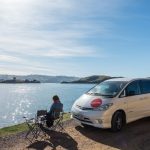
What to bring on your road trip
On a road trip through the Outback you’ll be driving through the desert with a small town every 100 to 200 kilometers. The sun is burning hot, especially in summer, and the rest stops only have a picnic table, a shelter, and a garbage bin. And those are the nice ones. If you’re lucky there’s a toilet as well. The most important thing you need to survive in these conditions: drinking water. You have to be prepared if you should strand in the middle of nowhere, so bring 10L of water per person as backup to get through worst case scenarios. This means you have to bring water for daily consumption as well. Everything is more expensive in the Outback, think about the distance that had to be covered to get the products there, so stock up on everything. We brought tons of water, snacks for during hiking, pancake shakes (add water and you have pancake batter), instant noodles, and instant pasta.
If you don’t have any fuel in your car, you won’t be getting far, so fuel is the second most important thing to bring. Start with a full gas tank, as fuel is way more expensive in the Australian Outback than in the coastal areas. We’ve seen prices over twice as much as we were used to so far. Don’t wait until your tank is almost empty, fill it when possible and watch out for signs warning for a long stretch of road without gas stations. It’s not a trick to get you to their gas station, it’s true. Glendambo, for example, is your last chance to fill your gas tank before getting to Coober Pedy 253km later. This is the longest drive without a gas station.
This next (and last) must-bring item may sound ridiculous, but we recommend to bring it anyway: a fly net. After two days of waving our hands in front of our face like two lunatics to chase the flies off, we finally bought a fly net. What a relief! You don’t look fashionable, but at least you won’t have any flies in your face. And believe us when we say there are A LOT of flies in the Australian Outback. Probably cheapest to buy a fly net beforehand, if you know where to be. We bought ours for $9.95 each at Kings Canyon Resort and saw them for $4.95 each at the Ayers Rock Campground.
What to expect from a road trip through the Outback
There’s only one main road through the Outback: Stuart Highway. This means most of the time you will be driving straight ahead: no turns, no roundabouts, no crossroads. Stuart Highway goes from Port Augusta to Tennant Creek. We only turned left on Lasseter Highway to Uluru, and right on Barkly Highway to get from Tennant Creek to Richmond. There’s 1,892 km between Port Augusta and Richmond, with a 859 km detour via Uluru and Kings Canyon, so you’ll be behind the wheel for quite some time.
Although there’s lots to see, like beautiful landscapes, giant cattle stations and emus crossing the road, it tends to get a little boring after a while. We brought our favourite songs and a whole range of podcast episodes of “This American Life” to keep us entertained. You need to rest and stretch your legs as well when doing trips from 400 to over 600 km per day. Our favourite way of inserting a little bit of action into these necessary stops is geocaching. Yes, even in the Australian Outback are geocaches hidden for you to find. Make sure to save those offline beforehand as there is often no cell phone reception between towns (or even in towns).
The landscape in the Australian Outback is different from everything we have ever seen. Most of the time it’s desertlike, beige or red sand, no trees, only low bushes, and everything seems flat. When you see red sand, you have reached the Red Centre, and from there it gets a little greener again. In the first part of our road trip through the Australian Outback, we saw a lot of dead kangaroos on the side (or in the middle) of the road, hit by inattentive drivers. Some have crows around them, others are already in various states of decomposing. The roos come out when it starts to get dark, so we recommend to minimize your driving after the sun goes down. Near Uluru and Kings Canyon, we didn’t see any, although we regularly drove in the dark there, on our way to the sunrise, or heading back after enjoying the sunset.
Apart from the landscape and the dead roos, you’ll see a lot of weird, cool, and funny things as well. Spoiler alert! The weirdest and at the same time coolest thing we’ve seen was the wreck of a Wicked campervan on the side of the road. It just stood there, as proof of travellers stranded on this exact spot, an adventure they’ll probably never forget. We saw another vehicle on its roof, a tree with tires in it, even a pair of hitchhikers. We had to slow down for emus and cows crossing the road, but never for a kangaroo.
I kept wondering what the small buildings with solar panels next to it were. You’ll pass them regularly. In the Old Timers Mine in Coober Pedy we learned these are solar powered repeater stations. The doors mention: “Optical fibre cable repeater”. Sometimes the boards warning for cattle or kangaroos crossing will be altered by passersby. Like a skateboard drawn underneath a kangaroo, or signs saying GRIN instead of GRID. We loved it, it’s fun and keeps you attentive of the signs, trying to discover more.
One last thing you’ll definitely come across are road trains: large trucks pulling up to three trailers that are quite an impressive sight on the road. Take care when overtaking (they are long!) and get out of their way. They can weigh up to 200 tonnes so a short braking distance is not one of their features.
However, what I liked most about our road trip through the Australian Outback is the Outback Greet. Whenever you cross someone else, you have to greet them by lifting the fingers on the hand that’s on top of the steering wheel. It makes you feel kind of connected, like “G’day mate, driving through the Outback as well? Enjoy!”. Not everyone greets back of course. Our field experiment showed that about one in three drivers you cross will greet you back. I always got really excited when someone greeted back, an easy gesture to make someone’s day!
Where (not) to pull over during your road trip
One of the first things worth stopping is Lake Hart. It’s a short walk from the car park, during which you’ll be accompanied by a swarm of flies buzzing around your head. Brecht was going crazy, cursing and waving his hands around his head like a madman. See why you should buy a fly net beforehand? On your way to the lake you’ll encounter the rusted remains of a car, before passing through a small tunnel underneath a railway. On the other side is the lake. Sort of. There’s no water (or at least not during our visit), it’s just an endless salt flat. For the first couple of meters the salt squeaks under your feet, like at Squeaky Beach, until you reach the solid layer of salt covering the ground. We wandered around for a while, and even found a dead scorpion.
Before getting to Coober Pedy, our first overnight stop, you have to pull over at Glendambo to fill your fuel tank. It’s the last fuel station for 253km, until you reach Coober Pedy. It’s definitely worth spending a couple of nights at this opal mining town, it’s like stepping back in time, into another world. We’ll tease you with a couple of photos, but for a full story we refer to our blogpost dedicated to Coober Pedy.
After Coober Pedy the ground turns into a kind of orange/red gravel, even the asphalt road is orange/red. You are in Australia’s Red Centre. Weirdly this means as well that the landscape turns a little greener than before, there are more trees. We made an unnecessary overnight stop at Erldunda, instead of heading to Kings Canyon right away. You can read in our blogpost about campsites in the Australian Outback how it’s only worth a stop for the food.
On our way from Kings Canyon to Uluru we pulled over at Kings Creek Station for WiFi, so Brecht could answer the support questions from his clients. Unfortunately there was no free WiFi as expected, but the same Roaming WiFi service as at Kings Canyon Resort. Brecht drank a cappuccino ($5.80) while getting some work done, while I talked with the owner about her sulphur-crested cockatoo, Charlie. She was sharing her bowl of cereal with him on the front porch when we arrived. She told me Charlie basically runs the place, hopping around making a lot of noise. Unfortunately he can’t fly because of something that happened when he was a baby. Since then he’s been with them. Fun to watch the bird for 15 minutes or so, but after that we were glad we could escape his noise. Kings Creek Station is a fuel station, but the fuel was extremely expensive there at the time. We did use their clean toilets.
A couple of hours later we briefly thought we already saw Uluru when we were still 120km away from the Ayers Rock Campground. However, the sign at a car park we passed shortly after, said Mount Connor Lookout. Rather impossible that you can see Uluru from that far away. On the other side of the road there is another salt flat.
During the trip from Alice Springs to Tennant Creek you should definitely make a short stop at the Devils Marbles, also named Karlu Karlu. These round boulders are absolutely fascinating. Read more about this stop in another blogpost. The weird dirt towers you’ll see on the side of the road, occasionally dressed in a T-shirt or hat, are termite mounds.
We absolutely loved the views on the drive from Mount Isa to Richmond. All the green reminded us of our visit to Amed in Bali. At that point, it doesn’t really feel like the Outback anymore, as there are electricity poles along the roads. We recommend you to stop at Mary Kathleen, the ghost mining town. To get there, you have to turn left from Barkley Highway, onto an unsealed road. After about 10 minutes of driving carefully slow you’ll reach a T-junction. On the right you’ll find the old mining town, on the left the mine where they found uranium over 50 years ago. There are some geocaches hidden in the ruins of the village. We didn’t wander around that long, and only found neglected asphalt roads and the foundations of a couple of houses.
Be warned, lots of (black) cows wander through the village, but we found they’re more scared of us than the other way around. We didn’t dare drive all the way to the mine though, as the small road seemed to require a 4WD vehicle. We didn’t risk going on foot either, as the sky was turning dark and small drops of rain started coming down. There’s supposed to be a nice blue lake there though, so worth a visit if you can. On our way back to the highway we encountered a cow road block. After a couple of minutes of waiting patiently in the car, the cows finally felt like moving out of the way. Don’t honk when this happens, as you won’t know what the cows will do when you scare them like that. When reaching the highway again, we were relieved our precious Spaceship campervan made it out in one piece.
On our way from Richmond to Townsville type=sight, just a couple of meters before driving through Charters Towers, we were caught in a storm of grasshoppers. We had never seen anything like it, it was literally raining big insects, probably grashoppers. They were everywhere, hitting the windshield, making me duck constantly, like you do when something is coming right at you. Should be horrible to drive through on a motorbike. Had a fun time cleaning dozens of dead ones from our car afterwards. Yuk!
Why you should do this amazing road trip
A road trip through the Australian Outback is definitely something we’d recommend to everyone who likes driving. You’re on a nice highway in the middle of nowhere, seeing another car every 10-30 minutes. The landscape is amazing, there’s nothing but nature for miles and miles. Apart from the unique driving experience there’s a lot to see as well. We loved our visit to Coober Pedy, the opal mining town, and had a great time hiking the Kings Canyon Rim Walk. Uluru and Kata Tjuta were impressive to say the least, and even more so at sunset and sunrise. If you don’t like driving you can take a plane or book a tourbus, but get out there, you won’t regret it!


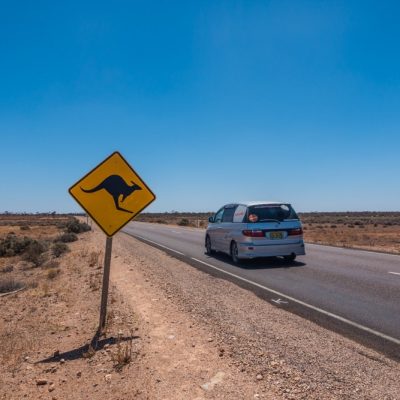



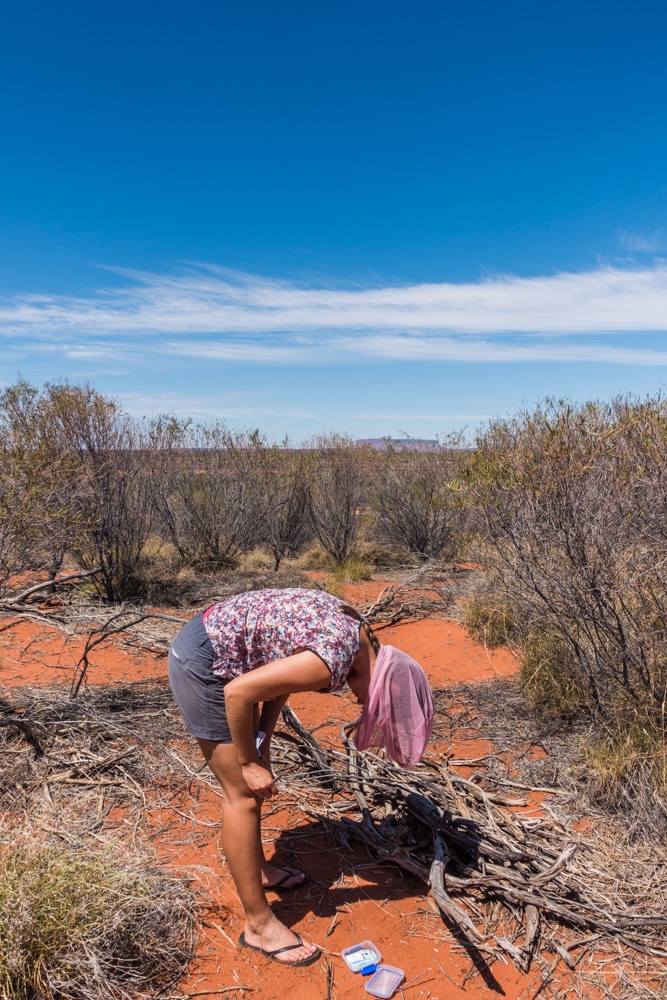


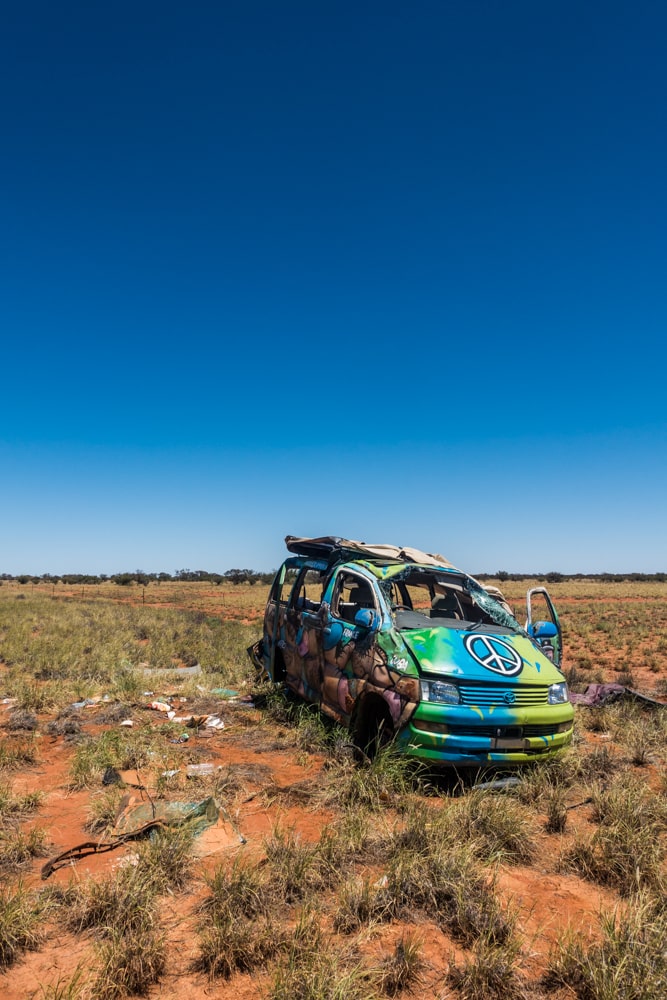


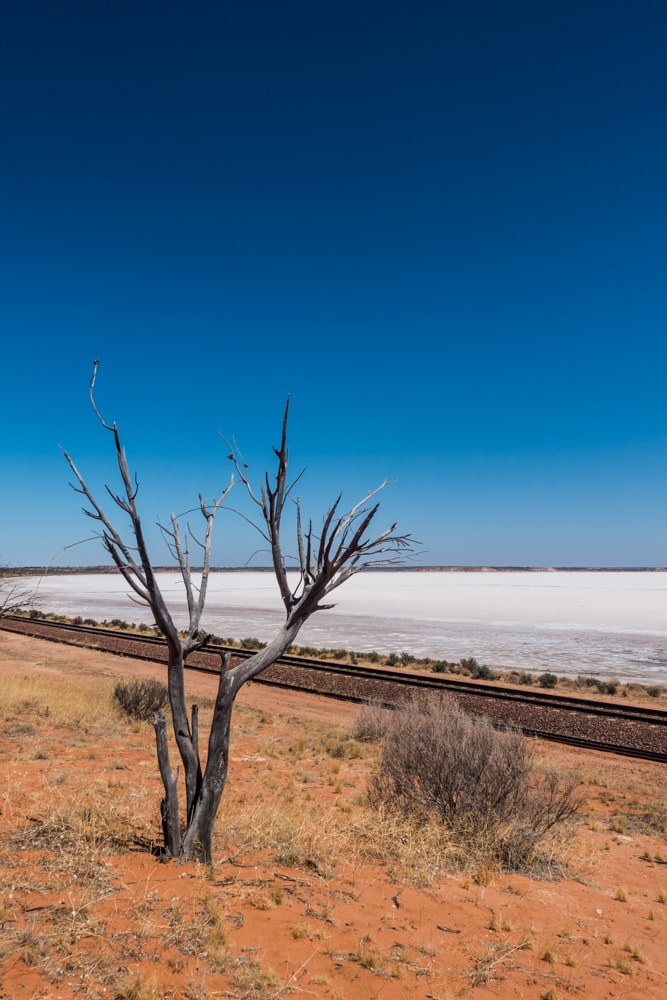


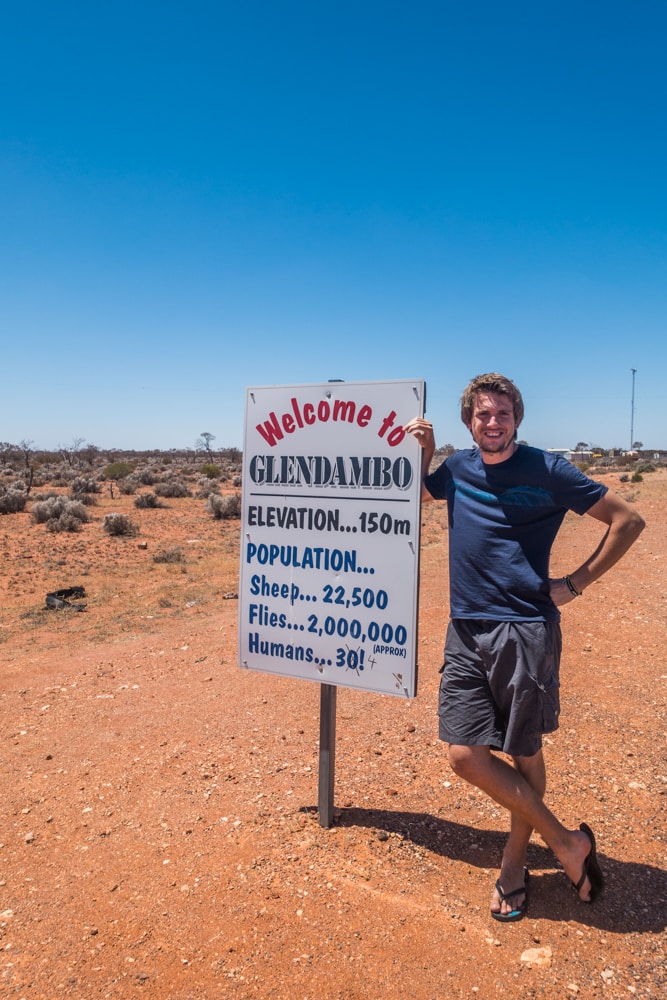




????